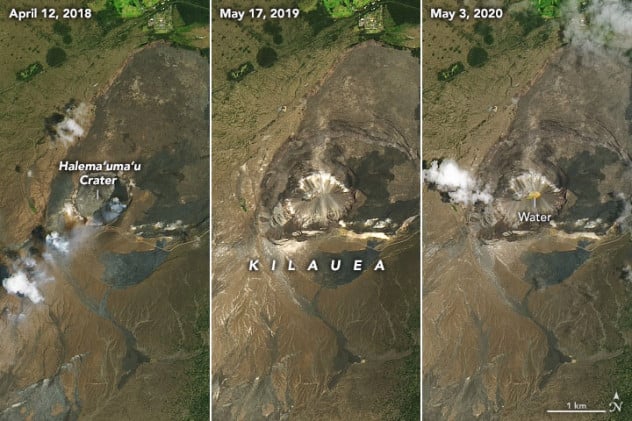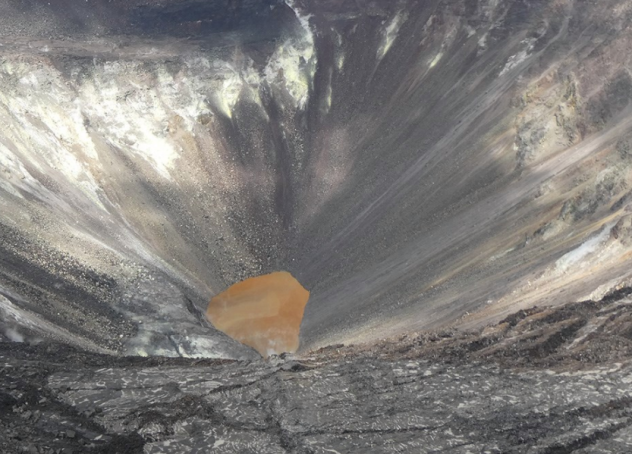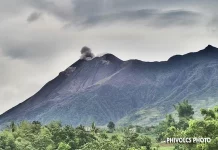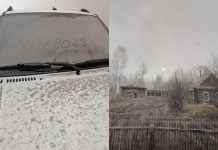The Halema‘uma‘u crater on Kilauea, located in Hawaii, has been relatively quiet over the last year after a frenzy of activity in 2018, which all began with an explosive eruption of ash 30,000 feet into the air during May.
But, since at least 2019, there has been a change that scientists believe could pose a potential danger to the Big Island. Water has started to collect in the caldera to form a lake.

NASA captured images showing before the lava lake in Halema‘uma‘u crater drained, after the caldera floor collapsed, and after the crater floor pooled with water.
A caldera is a large crater left behind in a volcano after an eruption. From 2010 until 2018, a lava lake had filled the caldera rather than water.
That changed in May 2018 when the eruption caused the lava lake to drain, collapsing the caldera floor and causing a hole nearly as deep as the 1,776-foot One World Trade Center.
The eruption also created a 459-foot cliff (140 meters) north of the crater.
New crater lake
About a year later, a helicopter pilot flying over the volcano noticed a mysterious green pool of water in the Halema‘uma‘u crater.
A second report of the same findings from a helicopter passenger prompted USGS-Hawaiian Volcano Observatory researchers to survey the green pool of water.
It was then discovered that water had indeed started to pool into the lowest part of the Halema’uma’u crater, and ever since the water was discovered in 2019, the depth of the lake has been steadily growing.
“We know that the crater floor dropped a little more than 70 meters below the water table in 2018. Any time that you punch a hole below the level of the water table, water is eventually going to come in and fill that hole,” explained Don Swanson, a volcanologist at the U.S. Geological Survey’s Hawaiian Volcano Observatory.
Currently, the water has an area larger than five football fields combined and is approximately 100 feet (30 meters) deep, according to NASA‘s Earth Observatory.
The water has also changed color from the original chalky green to a rusty brown, due to chemical reactions happening in the water.

Water and explosive eruption
As for how the water could affect a future eruption of the volcano, Swanson said it could contribute to an explosive eruption, since one of the main factors behind a big volcanic explosion is the amount of water and other gases that get caught up inside the magma.
“In one case, magma could rise quickly up the conduit and intersect with the lake,” said Swanson. “In the second, the crater floor could collapse and drop all of the water down to a zone where it would be quickly heated into steam.”
While an explosive eruption remains possible for Kilauea, Swanson said the next eruption could also happen slowly and all the water could evaporate.
“We do not want to be alarmist, but we also need to point out to the public that there is an increasing possibility of explosive eruptions at Kilauea,” said Swanson.
Only time will tell what is in store for Kilauea, but for now, the volcano is being closely researched and monitored by geologists.
There is also a giant tsunami looming for Alaska, scientists say:
More on Strange Sounds and Steve Quayle. [NEO, Accuweather]













[…] VOLCANO ALERT: Scientists warn of increasing possibility of explosive eruption at Kilauea volcano in Hawaii – https://strangesounds.org/2020/05/crater-lake-kilauea-volcano-explosive-eruption-update.html […]
Monitor the sun’s activity, when it releases toward earth it affects silica rich volcanoes. The soho probes could be used for early warning as Ben Davidson has pointed out many times.
In my last comment about Lo’ihi, I totally forgot about Kilauea.
Kilauea is located on the South by South East flank of Mauna Loa.
All the odds are against the Hilina slump which is almost in the middle of Loihi and Kilauea.
Sad that the scientists don’t mention the Hilina slump and the surrounding earthquakes.
Revelation 16:17-20 (KJV)
17 And the seventh angel poured out his vial into the air; and there came a great voice out of the temple of heaven, from the throne, saying, It is done.
18 And there were voices, and thunders, and lightnings; and there was a great earthquake, such as was not since men were upon the earth, so mighty an earthquake, and so great.
19 And the great city was divided into three parts, and the cities of the nations fell: and great Babylon came in remembrance before God, to give unto her the cup of the wine of the fierceness of his wrath. 20 And every island fled away, and the mountains were not found.
The USGS lady she never tell truth. Lucy is always lies indeed.
They know things they do not care for all of us.
WELL LIKE USUAL..THE USGS IS LIEING LIKE A RUG…LISTEN TO THE LORD..ITS MANUA LOA and yes its going to blow so hard it’ll kill everyone on the island,and usgs will say OH..we made a mistake,it was mauna loa,we are all crying over the mistake,ERXCET THEY KNOW ITS MAUNA LOA THATS GOING TO BLOW,they don’t have to guess THE LORD WARNED THEM,……